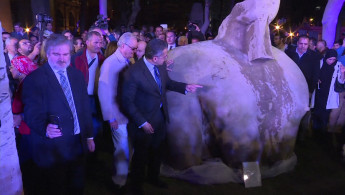Colossus found in Egypt may have depicted Psammetich I
A massive ancient colossus unearthed in Cairo last week may have depicted the famed pharaoh Psammetich I, Egypt's antiquities ministry said on Thursday.
The fragments of the eight-metre tall quartzite statue were found by an excavation team in ground water at the site of an ancient temple for King Ramses II, now a working class district in Cairo.
Earlier on, the statue was thought to be of Ramses II, who ruled Egypt for nearly six decades more than 3,000 years ago.
However, hieroglyphs on the statue's fragments point to it having depicted Psammetich I, who ruled from 664 to 610 BC, the statement said.
Antiquities minister Khaled al-Enany told a news conference that the hieroglyphs said "Strong Arm" - one of the names of the 26th Dynasty pharaoh.
But "we don't confirm 100 percent that it belongs to Psammetich I", he told reporters at the Cairo Museum, where the fragments were taken.
"If it belongs to this king, then it is the largest statue of the Late Period that was ever discovered in Egypt," he said.
"There is a possibility, albeit small, that Psammetich I reused an older statue that may be of Ramses II."
It would require more study to find out whether Psammetich I had simply appropriated an old statue.
| |
Psammetich I, credited for bringing stability to Egypt after years of turmoil, ruled some 600 years after Ramses II and sat on Egypt's throne for about 50 years.
The fragments found were part of the head and torso.
The excavation site was once the ancient Pharaonic capital of Heliopolis.
The temple of Matariya is well known as one of the most important sites of pharaonic religion, since it was considered to be the place of the world`s creation by the sun-god.
For about 2400 years, most kings erected their monuments there.
However, the site has been heavily destroyed over time due to its vicinity to modern Cairo.
The temple's blocks were used to build various monuments in Old Cairo, such as Bab el-Nasr and others.
The discovery of the quartzite statue has offered a piece of welcome news at a time when most of Egypt's 92 million people are struggling to make ends meet amid an economic crisis.
The tourism industry has yet to recover from the years of unrest following the 2011 uprising that toppled Hosni Mubarak.
Egyptian officials appeared keen to bring international attention to the find.
The statue will eventually be displayed at the yet-to-open Grand Egyptian Museum near the Giza Pyramids.





 Follow the Middle East's top stories in English at The New Arab on Google News
Follow the Middle East's top stories in English at The New Arab on Google News


